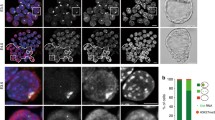Abstract
Considerable evidence suggests that the X inactive transcript gene,XIST/Xist, has a role in the initial steps of X chromosome inactivation in the female mammalian embryo. It is transcribed exclusively from inactive X chromosomes, and its noncoding transcript seems to be essential forcis inactivation. Unexpected for a developmental gene,XIST continues to be expressed in adult somatic cells. To determine the effect of reversal of inactivation on the expression ofXIST, we studied human X chromosomes that had been induced to reverse X inactivation by hybridization of chorionic villi cells from term placentas with mouse A9 cells. In nine hybrids with a reactivated X chromosome,XIST was either not expressed or expressed much less than the locus on the inactive X chromosome in the chorionic villi cells from which they were derived. The repressibility ofXIST by reversal of inactivation in these placental cells mirrors events that occur during the ontogeny of oocytes and indicates that the locus is subject to regulation in somatic cells long after inactivation is established in the embryo. The small residualXIST activity from these active chromosomes suggests that low levels ofXIST expression do not interfere with chromosome activity and raises the possibility that the induction ofcis inactivation requires a certain level ofXIST transcription. The chorionic villi hybrids provide an experimental system to study the developmental regulation ofXIST.
Similar content being viewed by others
Literature Cited
Chapman, V.M. (1986). InExperimental Approaches to Mammalian Embryonic Development, (eds.) Rossant, J., and Pedersen, R. (Cambridge University Press, Cambridge), pp. 365–398.
Tan, S.S., Williams, E.A., and Tam, P.P.L. (1993).Nature Genet. 3:170–174.
Ballabio, A., and Willard, H.F. (1992).Curr. Opin. Genet. Dev. 2:439–447.
Borsani, G., Tonlorenzi, R., Simmler, M.C., Dandolo, L., Arnaud, D., Capra, V., Grompe, M., Pizutti, A., Muzny, D., Lawrence, C., Willard, H.F., Avner, P., and Ballabio, A. (1991).Nature 351:325–329.
Brown, C.J., Ballabio, A., Rupert, J.L., Lafreniere, R.G., Grompe, M., Tonlorenzi, R.T., and Willard, H.F. (1991).Nature 349:38–44.
Kay, G.F., Penny, G.D., Patel, D., Ashworth, A., Brockdorff, N., and Rastan, S. (1993).Cell 72:171–182.
Salido, E.C., Yen, P.H., Mohandas, T.K., and Shapiro, L.J. (1992).Nature Genet. 2:196–199.
Richler, C., Soreq, H., and Wahrman, J. (1992).Nature Genet 2:192–195.
McCarrey, J.R., and Dilworth, D.D. (1992).Nature Genet. 2:200–203.
Brown, C.J., and Willard, H.F. (1994).Nature 368:154–156.
Rack, K.A., Chelly, J., Gibbons, R.J., Rider, S., Benjamin, D., Lafreniere, R.G., Oscier, D., Hendriks, R.W., Craig, I.W., Willard, H.F., Monaco, A.P., and Buckle, V.J. (1994).Hum Mol. Genet. 3:1053–1059.
Migeon, B.R., Wolf, S.F., Axelman, J., Kaslow, D.C., and Schmidt, M. (1985).Proc. Natl. Acad. Sci. U.S.A. 82:3390–3394.
Migeon, B.R., Schmidt, M., Axelman, J., and Ruta-Cullen, C. (1986).Proc. Natl. Acad. Sci. U.S.A. 83:2182–2186.
Migeon, B.R., Luo, S., Stasiowski, B.A., Jani, M., Axelman, J., Van Dyke, D.L., Weiss, L., Jacobs, P., Yang-Feng, T., and Wiley, J. (1993).Proc. Natl. Acad. Sci. U.S.A. 90:12025–12029.
Collins, C., Kuo, W.L., Segraves, R., Fuscoe, J., Pinkel, D., and Grey, J. (1991).Genomics 11:997–1006.
Lafreniere, R.G., Brown, C.J., Rider, S., Chelly, J., Taillon-Miller, P., Chinault, A.C., Monaco, A.P., and Willard, H.F. (1993a).Hum. Mol. Genet. 2:1105–1115.
Lehrach, H. (1990). InGenome Analysis, (eds.) Davies, K.E., and Tilghman, S.M. (Cold Spring Harbor Laboratory Press, Cold Spring Harbor, New York), pp. 39–81.
Migeon, B.R., Luo, S., Jani, M., and Jeppesen, P. (1994).Am. J. Hum. Genet. 55:497–504.
Chomczynski, P., and Sacchi, N. (1987).Anal. Biochem. 162:156–159.
Brown, C.J., Flenniken, A., Williams, B. and Willard, H.F. (1990).Nucleic Acids Res 18:4191–4195.
Tai, H.H., Gordon, J., and McBurney, M.W. (1994).Somat. Cell Mol. Genet. 20:171–182.
Migeon, B.R. (1990).Genet. Res (Cambridge) 56:91–98.
Driscoll, D.J., and Migeon, B.R. (1990).Somat. Cell Mol. Genet. 16:267–282.
Luo, S., Robinson, J.C., Reiss, A.L., and Migeon, B.R. (1993).Somat. Cell Mol. Genet. 19:393–404.
Kere, J., Nagaraja, R., Mumm, S., Ciccodicola, A., D'Urso, M., and Schlessinger, D. (1992).Genomics 14:241–248.
Author information
Authors and Affiliations
Rights and permissions
About this article
Cite this article
Luo, S., Torchia, B.S. & Migeon, B.R. XIST expression is repressed when X inactivation is reversed in human placental cells: A model for study ofXIST regulation. Somat Cell Mol Genet 21, 51–60 (1995). https://doi.org/10.1007/BF02255822
Received:
Issue Date:
DOI: https://doi.org/10.1007/BF02255822




